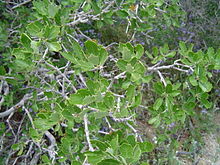bio.wikisort.org - Plant
Quercus berberidifolia, the California scrub oak, is a small evergreen or semi-evergreen shrubby oak in the white oak section of Quercus. It is a native of the scrubby hills of California, and is a common member of chaparral ecosystems.[3]
| California scrub oak | |
|---|---|
 | |
Conservation status | |
| Scientific classification | |
| Kingdom: | Plantae |
| Clade: | Tracheophytes |
| Clade: | Angiosperms |
| Clade: | Eudicots |
| Clade: | Rosids |
| Order: | Fagales |
| Family: | Fagaceae |
| Genus: | Quercus |
| Subgenus: | Quercus subg. Quercus |
| Section: | Quercus sect. Quercus |
| Species: | Q. berberidifolia |
| Binomial name | |
| Quercus berberidifolia Liebm. | |
| Synonyms[2] | |
| |
Description
Quercus berberidifolia grows to 1–2 metres (3+1⁄2–6+1⁄2 ft) tall, rarely to 4 m (13 ft), and has sharply toothed, dull green leaves which are 1.5–3 centimetres (5⁄8–1+1⁄8 inches) long and 1–2 cm (1⁄2–1 in) broad, leathery on their top surfaces and somewhat hairy underneath. The solitary or paired brown acorns are 1–3 cm (1⁄2–1 in) long and 1–2 cm (1⁄2–1 in) broad, and pointed or egg-shaped with thin caps when mature; they mature in about 6–8 months after pollination. In cooler, more exposed areas, scrub oak is usually a small, compact shrub, but in warm or sheltered areas the plant can spread out and grow several meters high.[4]
The epithet berberidifolia means "barberry-leaved," referring to the spiny leaf margins characteristic of Q. berberidifolia as well as of several species of Berberis.
Other species
The species is often known simply as scrub oak, though this name is also applied to other Quercus species, especially several which were formerly grouped under the single name Q. dumosa; all are found in scrubby habitats. Many other scrub-type oaks may be found in these regions, and careful inspection is required to identify individuals of Q. berberidifolia and its hybrids.
Quercus berberidifolia sometimes hybridizes with other species.
Chaparral origins
The word chaparral is derived from the Spanish word for scrub oak, chaparro. The non-specific meaning of the term is 'short in stature.' Because most scrub vegetation is rather low growing, the term is broadly applied to all of the vegetation in chaparral communities.
References
- Beckman, E. (2020). "Quercus berberidifolia". IUCN Red List of Threatened Species. 2020: e.T194068A173545406. doi:10.2305/IUCN.UK.2020-2.RLTS.T194068A173545406.en. Retrieved 12 November 2021.
- "Quercus berberidifolia Liebm.". World Checklist of Selected Plant Families (WCSP). Royal Botanic Gardens, Kew – via The Plant List.
- "Quercus berberidifolia". Calflora. Berkeley, California: The Calflora Database.
- Nixon, Kevin C. (1997). "Quercus berberidifolia". In Flora of North America Editorial Committee (ed.). Flora of North America North of Mexico (FNA). Vol. 3. New York and Oxford – via eFloras.org, Missouri Botanical Garden, St. Louis, MO & Harvard University Herbaria, Cambridge, MA.
External links
На других языках
- [en] Quercus berberidifolia
[es] Quercus berberidifolia
Quercus berberidifolia conocido como encinillo[1] es un pequeño roble en forma de arbusto de hoja perenne, perteneciente a la sección Quercus (sinónimos Lepidobalanus y Leucobalanus), los robles blancos de Europa, Asia y América del Norte. Tienen los estilos cortos; las bellotas maduran en 6 meses y tienen un sabor dulce y ligeramente amargo, el interior de la bellota tiene pelo. Las hojas carecen de una mayoría de cerdas en sus lóbulos, que suelen ser redondeados.Другой контент может иметь иную лицензию. Перед использованием материалов сайта WikiSort.org внимательно изучите правила лицензирования конкретных элементов наполнения сайта.
WikiSort.org - проект по пересортировке и дополнению контента Википедии
